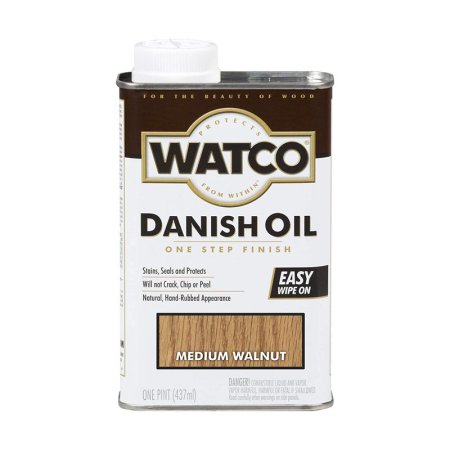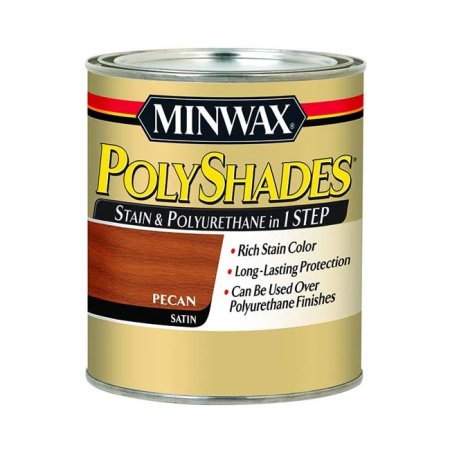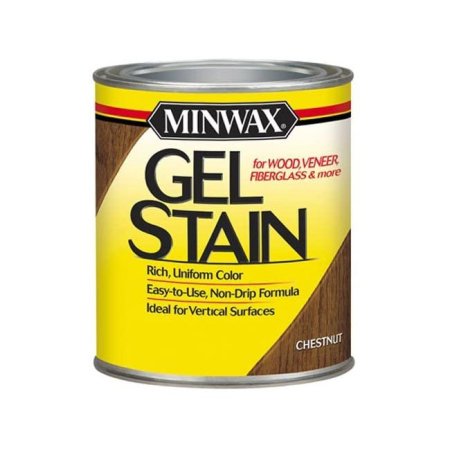
We may earn revenue from the products available on this page and participate in affiliate programs. Learn More ›
Wood stain is a paint-like product comprised of colorant dissolved or suspended in a solvent or other medium. It’s used to enrich the look of wood, bringing out the natural grain and adding depth and color; usually, a stain is employed to darken light varieties like pine, making them resemble deeper-toned woods, such as walnut or cherry. Whether you’re staining a bookcase or aiming to match the color of new wood cabinets to the trim in your kitchen, choosing the right stain can help make the project a masterpiece. Keep reading to learn what to look for when shopping for wood stain, and to find out why we chose the following formulas as best for common projects.
- BEST WATER-BASED STAIN: SamaN Wood Stain
- BEST OIL-BASED STAIN: Watco Danish Oil Wood Finish
- BEST VARNISH STAIN: Minwax Polyshades Stain & Polyurethane
- BEST GEL STAIN: Minwax Gel Stain
- BEST EXTERIOR STAIN: Ready Seal Wood Stain and Sealer

Key Considerations for Choosing a Wood Stain
Understand the Formulations
Before buying a stain, understand the properties of the four different formulas available.
Water-Based Stain: Comprised largely of pigment and water—and sometimes a small amount of solvent—water-based stains are free of or low in VOCs and less likely to create toxic fumes during application. Water-based stain usually dries quickly, often within a few hours, and is usually used on interior projects, such as hardwood floors and trim. The downside to water-based stain is that the water content raises the grain of the wood; be sure to sand the surface to get rid of roughness before applying a final coat of sealer. Water-based stains can be applied by brushing or spraying, and tools clean up easily with plain soap and water.
Oil-Based Stain: Because it contains oil, this stain naturally repels water to a degree, making it a good choice for wood that might get wet, such as a kitchen tabletop. Oil-based stain also contains solvents with volatile organic chemicals (VOCs), which help the oil and pigments to blend, but can also create noxious fumes, so only use oil-based stain in well-ventilated areas. Depending on the brand, oil stain can take up to two days to dry sufficiently before a finish coat, such as clear polyurethane or varnish, can be applied.
While oil stain is found in both indoor and outdoor products, it can only be applied in temperatures between 50° F and 80° Fahrenheit. At lower temps, it can become thick and unworkable, and at higher temps, especially in high humidity, the stain tends to “sweat” and leave blotches on the surface. Oil-based stain can be applied by spraying or brushing, and cleaning the tools afterward requires the use of a solvent, such as turpentine or mineral spirits.
Varnish Stain: Varnish stain, a formula found in some interior stain products and the majority of exterior stain products, is a combination of oil-based wood stain and surface sealer. A two-in-one, time-saving product, it contains oil, solvents, pigments, and resins, which both dye the wood grain and also form a hardened protective coating. Because they contain solvents, varnish stains are often high in VOCs and should be used only in well-ventilated areas.
While varnish stain can be applied by brushing or spraying, brushing offers a smoother finish best suited to interior projects. Any tiny bubbles caused by spraying will barely be noticeable on large exterior surfaces. Whatever application technique you choose, be sure to coat the surface carefully and uniformly to avoid blotchiness and color discrepancies. Cleaning tools afterward requires a solvent, such as turpentine or mineral spirits.
Gel Stain: Though oil-based, gel stains aren’t as messy as regular oil- and water-based stains, because the gel won’t drip, splatter, or run. The gel is created by whipping oil, solvents, and pigments to produce a thick, smooth consistency that won’t separate. As with other oil-based stains, you must have adequate ventilation when applying with a brush (the formula is too thick for a spray), only apply at temperatures between 50° and 80° Fahrenheit, and use turpentine or mineral spirits for cleanup.
Consider Opacity and Protection
Most interior wood stain products are designed to impart a transparent dye that will not obscure the grain of the wood. Exterior stains, such as deck and fence stain, often contain higher amounts of pigment, which serve to conceal some or most of the grain. When buying exterior stain, check the opacity on the label to get the look you desire.
- Toner—contains just a hint of pigment so the natural wood grain is visible.
- Semi-transparent—adds a rich color but the grain is still fairly visible.
- Semi-opaque—imparts deep color and obscures most of the wood grain.
- Opaque—similar to paint. Completely covers the grain with dense color.
Also, because exterior wood must bear the brunt of the harsh sun and whatever else Mother Nature dishes out, make sure the product you purchase for a deck or fence contains UV and mildew protection.
Our Top Picks
Best Water-Based Stain
SamaN Wood Stain
A low VOC stain, SamaN Wood Stain is ideal for all types of interior wood projects—trim, cabinets, doors, and so on. One 12-ounce bottle covers up to 75 square feet and dries in as little as two hours. It’s available in dozens of enticing shades, including Canadian Maple, Spice, and Paprika, and can be brushed or sprayed on. The SamaN product stands out perhaps most of all for its great-looking color. Application is easy, and cleanup is even easier.
Best Oil-Based Stain
Watco Danish Oil Wood Finish
For rich, luxurious wood tones, Watco’s Danish Oil Wood Finish is an excellent interior stain available in multiple colors, including Walnut, Golden Oak, and Fruitwood. It can be applied by brushing or spraying (a pint covers up to 85 square feet) and dries in about six hours. Applying additional coats will increase the depth of color and sheen. Only note that cleaning up an oil-based stain like this requires the use of a solvent, such as mineral spirits). It’s worth the effort, though, as the Danish Oil Wood Finish imparts a gorgeous, hand-rubbed look.
Best Varnish Stain
Minwax Polyshades Stain & Polyurethane
An interior stain/varnish combo, oil-based Minwax Polyshades Stain & Polyurethane comes in 14 colors with either a satin or gloss sheen. One quart covers up to 150 square feet, and while a single coat dries in about six hours, two coats are recommended for the richest color and sheen. Be sure to apply Polyshades with a high-quality brush; the product rewards proper application with a beautiful, durable finish.
Best Gel Stain
Minwax Gel Stain
There are no worries about drips and runs—even when staining vertical surfaces—when you work with Minwax Gel Stain. The product provides uniform color in 12 shades (e.g., chestnut, coffee, and hickory) and can be used on either interior or exterior wood (though exterior surfaces must be coated with a protective finish, such as spar varnish). Apply with a brush, cloth, or foam applicator (the quart size covers up to 200 square feet), then wait 10 hours or overnight to re-coat. A solvent is necessary for cleanup, but there won’t be much to clean thanks to the gel stain’s no-mess application.
Best Exterior Stain
Ready Seal Wood Stain and Sealer
For great-looking decks, fences, and outdoor furniture, check out double-duty Ready Seal Wood Stain and Sealer. One gallon of this semi-transparent stain-and-sealer combo covers up to 125 square feet on most types of wood used outdoors (including cedar and spruce). Applicable with a brush, a roller, or a sprayer, Ready Seal works best with two light coats, the second of which you can apply in as little as 45 minutes. Ready Seal has won the hearts of many for its ability to protect against the effects of UV rays and moisture.








